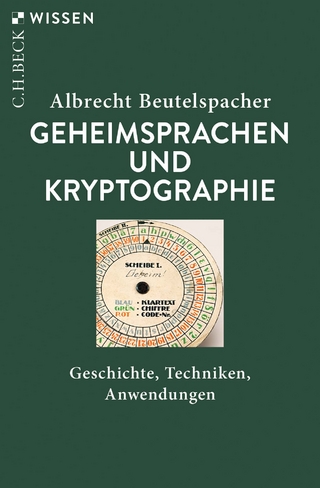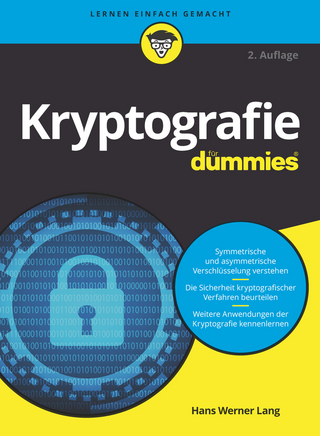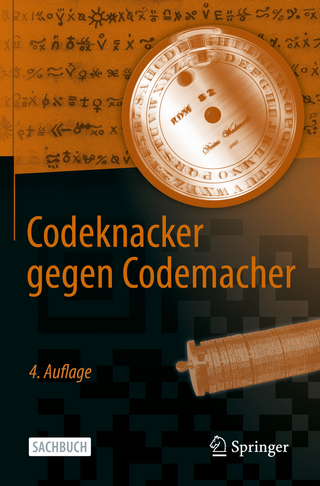
Cybersecurity in Smart Homes
Iste Ltd (Verlag)
978-1-78945-086-6 (ISBN)
Rida Khatoun is Associate Professor at Telecom ParisTech, France. His current research interests are focused on cybersecurity in areas such as connected cars, cloud computing and the Internet of Things, as well as cybersecurity architectures, intrusion detection systems and blockchain technology.
Chapter 1 Home Automation Solutions for SecureWSN 1
Corinna SCHMITT and Marvin WEBER
1.1 Introduction 2
1.2 Background 4
1.2.1 SecureWSN 4
1.2.2 Communication standards 8
1.2.3 The monitor-analyse-plan-execute-knowledge model 12
1.2.4 Hardware and libraries 14
1.3 Design decisions 15
1.3.1 Requirements 16
1.3.2 HAIFA architecture 18
1.3.3 WebMaDa integration 29
1.4 Implementation 30
1.4.1 CoMaDa integration 30
1.4.2 HAIFA’s ZigBee Gateway 48
1.4.3 WebMaDa integration 55
1.4.4 Uploading HA data to WebMaDa 56
1.4.5 Sending HA messages from WebMaDa to CoMaDa 59
1.4.6 WebMaDa’s frontend 62
1.5 Evaluation of HAIFA 64
1.5.1 Actuator interoperability (R1) 65
1.5.2 Rule-based automation (R2) 65
1.5.3 Node hardware interoperability (R3) 68
1.5.4 CoMaDa and WebMaDa management (R4) 68
1.6 Summary and conclusions 68
1.7 Acknowledgements 69
1.8 References 70
Chapter 2 Smart Home Device Security: A Survey of Smart Home Authentication Methods with a Focus on Mutual Authentication and Key Management Practices 75
Robinson RAJU and Melody MOH
2.1 Introduction 75
2.2 Smart home – introduction and technologies 77
2.2.1 Smart home – introduction 77
2.2.2 Smart home devices – categories 79
2.3 Smart home security 80
2.3.1 Threats 81
2.3.2 Vulnerabilities 82
2.3.3 IoT communication protocols 84
2.3.4 Enhancements to IoT communication protocols 86
2.3.5 IoT security architectures 87
2.4 Smart home authentication mechanisms 91
2.4.1 Stages of defining an authentication protocol for IoT 92
2.4.2 Taxonomy of authentication schemes for IoT 93
2.5 A primer on mutual authentication and key management terminologies 96
2.5.1 X.509 certificate 97
2.5.2 CoAP and DTLS 99
2.5.3 Tls 1.3 101
2.5.4 Key management fundamentals 102
2.6 Mutual authentication in smart home systems 104
2.6.1 Device and user onboarding 105
2.6.2 Flow of user authentication and authorization 106
2.6.3 Examples of mutual authentication schemes 107
2.7 Challenges and open research issues 112
2.8 Conclusion 113
2.9 References 114
Chapter 3 SRAM Physically Unclonable Functions for Smart Home IoT Telehealth Environments 125
Fayez GEBALI and Mohammad MAMUN
3.1 Introduction 126
3.2 Related literature 129
3.3 System design considerations 130
3.4 Silicon physically unclonable functions (PUF) 131
3.4.1 Mutual authentication and key exchange using PUF 132
3.4.2 Fuzzy extractor 133
3.5 Convolutional encoding and Viterbi decoding the SRAM words 133
3.6 CMOS SRAM PUF construction 136
3.6.1 SRAM PUF statistical model 138
3.6.2 Extracting the SRAM cell statistical parameters 141
3.6.3 Obtaining the golden SRAM PUF memory content 142
3.6.4 Bit error rate (BER) 142
3.6.5 Signal-to-noise ratio (SNR) for SRAM PUF 143
3.7 Algorithms for issuing CRP 144
3.7.1 Algorithm #1: single-challenge 144
3.7.2 Algorithm #2: repeated challenge 147
3.7.3 Algorithm #3: repeated challenge with bit selection 148
3.8 Security of PUF-based IoT devices 150
3.9 Conclusions 151
3.10 Acknowledgements 151
3.11 References 151
Chapter 4 IoT Network Security in Smart Homes 155
Manju LATA and Vikas KUMAR
4.1 Introduction 156
4.2 IoT and smart home security 159
4.3 IoT network security 164
4.4 Prevailing standards and initiatives 169
4.5 Conclusion 172
4.6 References 172
Chapter 5 IoT in a New Age of Unified and Zero-Trust Networks and Increased Privacy Protection 177
Sava ZXIVANOVICH, Branislav TODOROVIC, Jean Pierre LORRÉ, Darko TRIFUNOVIC, Adrian KOTELBA, Ramin SADRE and Axel LEGAY
5.1 Introduction 178
5.2 Internet of Things 179
5.3 IoT security and privacy challenges 182
5.3.1 Security challenges 183
5.3.2 Privacy challenges 184
5.4 Literature review 187
5.5 Security and privacy protection with a zero-trust approach 190
5.6 Case study: secure and private interactive intelligent conversational 193
5.6.1 LinTO technical characteristics 194
5.6.2 Use case 195
5.6.3 Use case mapping on the reference architecture 197
5.7 Discussion 197
5.8 Conclusion 198
5.9 Acknowledgements 199
5.10 References 199
Chapter 6 IOT, Deep Learning and Cybersecurity in Smart Homes: A Survey 203
Mirna ATIEH, Omar MOHAMMAD, Ali SABRA and Nehme RMAYTI
6.1 Introduction 203
6.2 Problems encountered 205
6.3 State of the art 207
6.3.1 IoT overview 207
6.3.2 History 208
6.3.3 Literature review 208
6.3.4 Advantages, disadvantages and challenges 209
6.4 IoT architecture 212
6.4.1 Sensing layer 213
6.4.2 Network layer 213
6.4.3 Service layer 213
6.4.4 Application–interface layer 213
6.5 IoT security 214
6.5.1 Security in the sensing layer 214
6.5.2 Security in the network layer 215
6.5.3 Security in the service layer 215
6.5.4 Security in the application–interface layer: 216
6.5.5 Cross-layer threats 216
6.5.6 Security attacks 216
6.5.7 Security requirements in IOT 218
6.5.8 Security solutions for IOT 219
6.6 Artificial intelligence, machine learning and deep learning 221
6.6.1 Artificial intelligence 222
6.6.2 Machine learning 222
6.6.3 Deep learning 224
6.6.4 Deep learning vs machine learning 225
6.7 Smart homes 227
6.7.1 Human activity recognition in smart homes 227
6.7.2 Neural network algorithm for human activity recognition 228
6.7.3 Deep neural networks used in human activity recognition 230
6.8 Anomaly detection in smart homes 233
6.8.1 What are anomalies? 233
6.8.2 Types of anomaly 233
6.8.3 Categories of anomaly detection techniques 233
6.8.4 Related work of anomaly detection in smart homes 234
6.9 Conclusion 237
6.10 References 238
Chapter 7 sTiki: A Mutual Authentication Protocol for Constrained Sensor Devices 245
Corinna SCHMITT, Severin SIFFERT and Burkhard STILLER
7.1 Introduction 246
7.2 Definitions and history of IoT 248
7.3 IoT-related security concerns 251
7.3.1 Security analysis guidelines 253
7.3.2 Security analysis by threat models 255
7.3.3 sTiki’s security expectations 256
7.4 Background knowledge for sTiki 258
7.4.1 Application dependencies for sTiki 258
7.4.2 Inspiring resource-efficient security protocols 260
7.5 The sTiki protocol 264
7.5.1 Design decisions taken 266
7.5.2 Implementation of sTiki’s components 267
7.6 sTiki’s evaluation 270
7.6.1 Secured communication between aggregator and server 271
7.6.2 Secured communication between collector and aggregator 275
7.6.3 Communication costs 276
7.6.4 Integration into an existing system 277
7.6.5 Comparison to existing approaches 278
7.7 Summary and conclusions 279
7.8 Acknowledgements 280
7.9 References 281
List of Authors 287
Index 289
| Erscheinungsdatum | 17.08.2022 |
|---|---|
| Verlagsort | London |
| Sprache | englisch |
| Maße | 10 x 10 mm |
| Gewicht | 454 g |
| Themenwelt | Mathematik / Informatik ► Informatik ► Netzwerke |
| Informatik ► Theorie / Studium ► Kryptologie | |
| ISBN-10 | 1-78945-086-1 / 1789450861 |
| ISBN-13 | 978-1-78945-086-6 / 9781789450866 |
| Zustand | Neuware |
| Haben Sie eine Frage zum Produkt? |
aus dem Bereich


